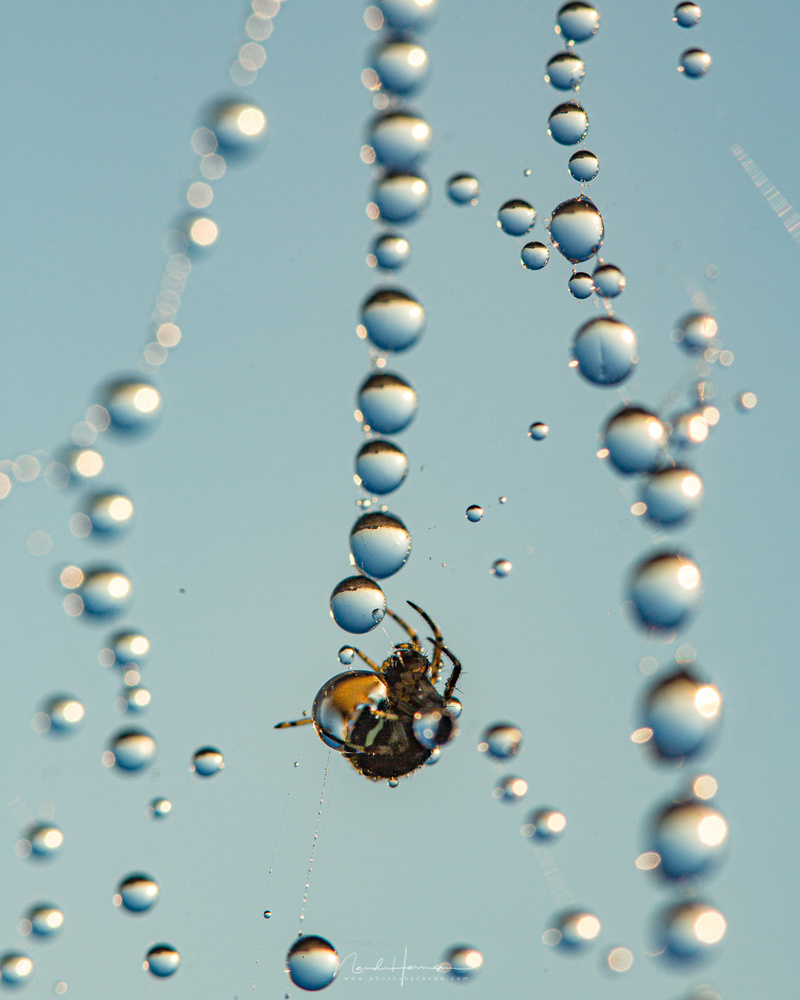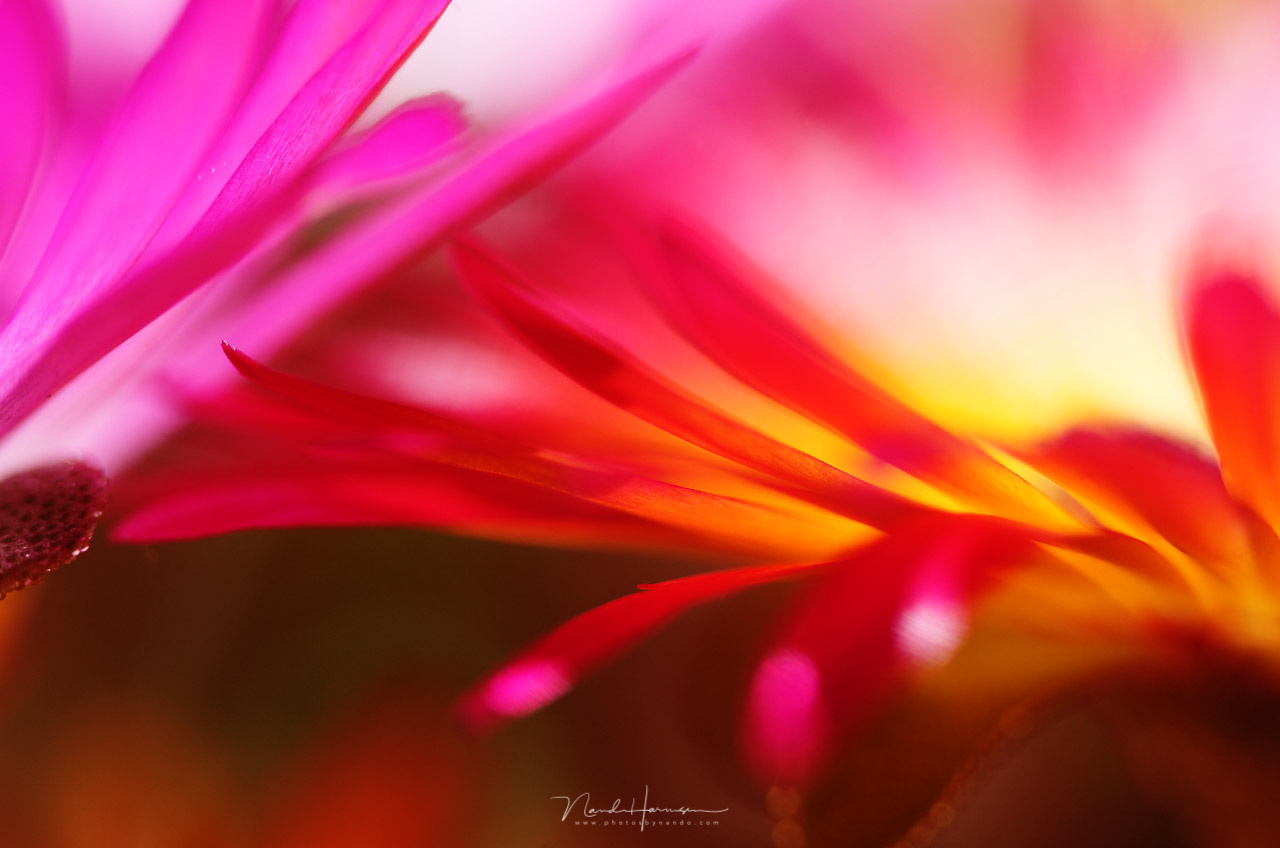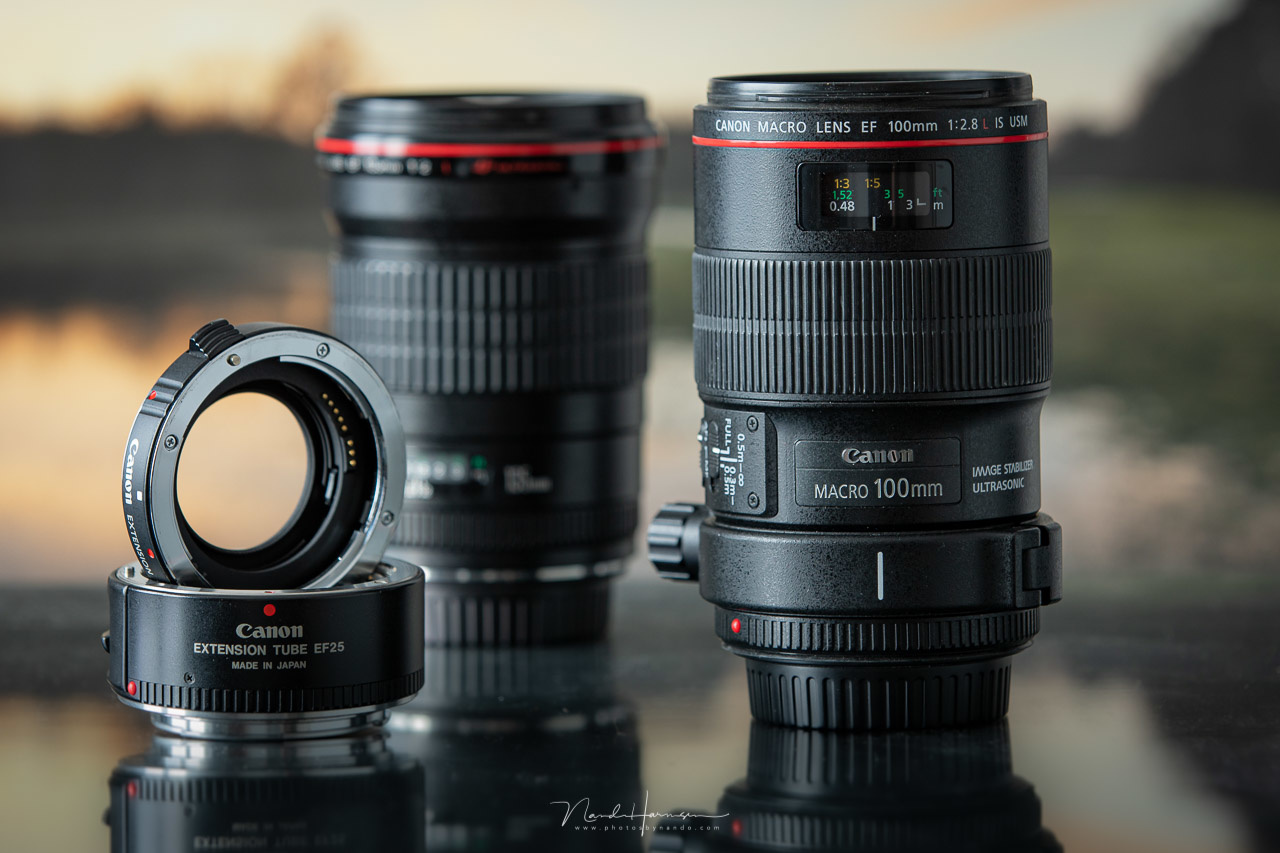If you want to photograph small things, you need to get close. For that, you can choose a macro lens. But there is an alternative that is much cheaper. Extension tubes transform any lens into a macro lens. But what is the better choice?
A macro lens is a wonderful tool that allows us to capture a subject in a 1:1 magnification. Some macro lenses can magnify even more, but these are very specialized lenses. Most of the time, a 1:1 magnification is more than enough.
Buying a macro lens can be expensive, although there are also relatively cheap macro lenses available. But extension tubes will always be cheaper. These tubes bring a lot of flexibility. You can use an extension tube with every normal lens. These tubes allow you to focus real close with nice magnifications, especially with super tele lenses. That combination is perfect for shooting frogs and other small wildlife that are difficult to approach.

A European Tree Frog, shot with a 70-200mm lens and a 25mm extension tube. It allowed me to get a nice magnification without the need to get close to the subject.
What Are Extension Tubes?
An extension tube is nothing more than a spacer between a lens and camera. The extension tubes are hollow, without any glass. The only thing an extension tube has is the contact points for the communication between camera and lens. If you are in the market for extension tubes, make sure your set has those contact points.
Because the lens will be farther from the sensor, the minimum focal distance will decrease. Because the distance between lens and camera is larger, the image circle will become larger at the sensor plane. That will introduce a larger magnification.
Infinity Is Out of Reach
Because the distance from the lens to the camera is larger, you will lose the ability to focus on infinity. In a sense, the complete focus range is shifted towards you.
Let me give you an example. A Canon EF 135mm f/2L lens has a focus range from 0.9 meters until infinity. If I place a 25mm extension tube between the lens and the camera, this focus range will change from 0.4 meters up to 0.7 meters. I have the ability to get closer to the subject, but I can’t focus on infinity anymore.

Although you will lose the ability to focus at infinity, for macro, you don't need it. This image of the garden spider and dew drops was shot with the 100mm macro lens.
Calculate the New Magnification Yourself
The magnification factor of the lens will increase when extension tubes are used. Unfortunately, it is nearly impossible to reach the 1:1 magnification of a real macro lens. If I take the example of the Canon EF 135mm f/2L lens, with a 25mm extension tube the magnification will change from 0.19x to 0.38x.
It is possible to calculate the additional magnification when using extension tubes. Just divide the extension tube length by the focal length of the lens. The outcome is the extra magnification on top of the standard magnification.
Extra magnification = tube length (mm) / focal length (mm)
The Difference With a Macro Lens
Although the differences between extension tubes and a macro lens are obvious, I would like to mention these nevertheless. There are three main differences. The macro lens can focus from a minimum focus distance up to infinity, and with extension tubes, that is not possible. The macro lens can reach up to a magnification of 1:1 or even more. With extension tubes, you can’t.
On the other hand, extension tubes are not expensive. But the biggest benefit is the ability to use extension tubes with every lens you own. As a matter of fact, you can also use these tubes with macro lenses, reaching beyond the 1:1 magnification.

My award-winning image of livingstone daisies. I took this image with a macro lens combined with extension tubes.
How About Image Quality?
If I would try to compare a macro lens with a lens fitted with extension tubes, I would be comparing the image quality of the lenses themselves rather than the extension tubes. After all, these tubes don't have extra glass inside that can influence image quality.
I decided to do the test nevertheless by comparing the images between the Canon EF 100mm f/2.8L macro lens and the Canon EF 135mm f/2L lens with stacked Canon EF 12mm and Canon EF 25mm extension tubes. Together, these tubes are 37mm which gives me a 37/135 = 0.27 times extra magnification. In this case, I will reach a 0.46x magnification with this combination.
The reason I chose the EF 135mm f/2L is simple. This lens is famous for its image quality. The focal length may be a bit longer compared to the 100mm of the macro lens, but it doesn’t differ that much. I thought it would be a reasonably fair comparison. I tried to use the same magnification with both the EF 135mm f/2L and the EF 100mm f/2.8L Macro.
For the test, I have photographed a flat surface and aligned the camera and lens to my best ability. I have photographed this flat surface with three different apertures: f/2.8, f/8, and f/22. I used manual focus and focused with live view right in the center of the image.

The test shows the red rectangle of this image with three different apertures, both with the 100mm macro and the 135mm with 36 mm extension tubes.
Because a resized image won’t show much difference, I have enlarged the two areas indicated by the rectangles to have an almost 100% crop. Let’s have a look at the crops with the three different apertures.
Aperture f/2.8
If you compare these images, you see how the middle of the image is nearly the same in quality. There might be some small differences, but you have to look carefully to notice them. In the corner, it is a completely different story. The use of extension tubes on the 135mm lens results in a significantly reduced sharpness. But you can argue this is due to the image quality of the 135mm lens.
Aperture f/8
The sweet spot for many lenses is more or less f/8. At this aperture, the lenses should perform at their best. If you compare the images, you’ll see how the image sharpness in the middle is very good with both lenses.
The corners of both images show a clear increase in sharpness. Although the quality of the macro lens is not reached, the difference of the 135mm with extension tubes compared to f/2.8 is significant.
Aperture f/22
By closing the aperture down to f/22, the images don’t show a better image quality. At this point, diffraction plays an important role, reducing the overall sharpness of both lenses. This has to do with physics and is inevitable.
The reduced image sharpness is most obvious in the center part of the image. In the corners, the reduced sharpness is less obvious. The diffraction seems to be less than the corner sharpness that was present at f/8.
Which Is the Better Choice?
The macro lens will produce a better overall result compared to the 135mm with extension tubes. But you have to be careful with conclusions. The image quality is probably depending on the lens that is used with the extension tubes. An exceptionally good lens with extension tubes may outperform the macro lens. On the other hand, an exceptionally good lens may cost even more than a macro lens. In any way, I believe the macro lens wins the comparison.
And then again, if you are just an occasional macro photographer, or if you don’t have the money to spend on a macro lens, extension tubes are a very good choice. These tubes are small, lightweight, and can be used with almost every lens, even a macro lens.
Do you own extension tubes or do you prefer a macro lens? Perhaps you own both and use these tubes next to a macro lens or together with a macro lens. Please share your thoughts and experiences in the comments below.
If you want to learn all the tips and tricks of getting incredible macro shots, Fstoppers teamed up with Andres Moline to produce Mastering Macro Photography. If you purchase it now, or any of our other tutorials, you can save a 15% by using "ARTICLE" at checkout.















Every article you publish, one more "mystery" of photography is solved. Macro lenses vs extension tubes is a question many do ourselves, but few try to address it with side by side comparisons like you. I have used wide angles inverted for macro, and was considering to buy proper equipment. Now I have a rough idea what to expect.
I have one question though. For the same magnification, is the working distance similar for macro lenses and extension tubes?
Thank you for you comment.
Approx. the same magnification, not exactly. I think I used the minimum focus distance of the 135L with extension tubes to reach the maximum magnification. That is 40 cm.
The 100L macro has a minimum focus distance of 30 cm and reaches a 1:1 magnification at that point. I increased the distance to have about the same framing. So it will something between 40 cm and 50 cm I guess.
Thanks again!
Even a macro lens doesn't have to be very expensive -- the EF-M 28mm macro has a maximum magnification of 1.2x and is really not that expensive, for instance. And gives quite good image quality for the APS-C system. The biggest drawbacks of that lens are however that you have to get very near to get good magnification, and that it's limited to the EOS-M system, which doesn't seem to get much love from Canon these days.
Tamron has a decently prices macro lens for fullframe cameras at 90mm, which could also be used for portraits for instance, and is quite well regarded.
These days I use my Fuji 80mm macro with a 16mm extension ring to achieve 1.2x magnification.
Ah well, extension tubes are about 100 euro for a set of three. Still less expensive ;)
True, less expensive, but not as much magnification. The EF-M 28mm is "only" €300, good value for money in my opinion if you have a camera in that system!
(And TBH I wouldn't recommend an EOS-M camera anymore at this moment in time but -- if you happen to have one such camera, that macro lens is a pretty good value for money!)
A number of systems have a lower cost macro lens available. While I have others, my M.Zuiko 30mm f/3.5 ean $99 on an annual Olympus sale. It's a plasticky lens, but shoorts way above its price point in image quality. Sure a shorter lens needs to get closer, but you also get more of an impact from the same extexsion tubes, if getting close us no problem.
I was not aware of that lens since I'm not familiar with the Olympus system. Thanks for adding another macro lens that's good value for money! :)
What does the IS of the tested macro lens bring to the table?
Nothing for this comparison. I didn't use IS at all since I shot all images from tripod.
Sometimes I use a Canon 70-300 L with .12 and .25 adapters because it has IS and also gives me distance from the subject, but I also prefer to use a 100 mm Makro-Planar Zeiss ZE for better IQ. Sometimes I use the extenders on the macro lens as well, and it is a phenomenal lens. For macro, I always try to get just a sliver of sharpness and all blur. To get that, you don't need great lenses, and those lenses are way overkill. And I actually prefer the old 5dmk2 for less sharpening in-camera. I also used to use an even longer sports Sigma 170 - 500 with an extender on a tripod for compression, but it is rather clunky (I just sold it), and cannot be handheld for macro (no IS).
My other choice for a cheap alternative would be a magnifying lens that screws on top of another lens. Set of 4 ( 1x, 2x , 4x, 10x) rather inexpensive. Curious as to why you did not mention these?
I never used those filters. That is why I did not mention them.
To be honest, I can't image those things will provide a good quality image. But correct me if I'm wrong
:)
You can get high quality supplementary lenses. Check out Raynox images on Flickr . I have one and I'm very impressed with the quality. They also have advantages and disadvantages. You can use them on multiple lenses but are not useful on wide angle lenses. Secondly they are much easier to whip on and off, compared to extension tubes, the Raynox just clips into the filter thread. I used to use extension tubes and I think the Raynox gives better contrast, probably because there is less extraneous light bouncing about behind the lens.
Some people I spoke were less enthousiastic about the Raynox. It would be nice to check it out myself, someday. Thanks for sharing your experience with these lenses.
Great article. Macro lens usage needs all the explanation one can find.
A suggestion. The article says...
"this focus range will change from 0.4 meters up to 0.7 meters"
"from" is confusing. It reads like "it was 0.4m and now is 0.7m"
Perhaps
"this focus range shits, now starting at 0.4 meters but ending at 0.7 meters"
Hm, I have to look into that kind of writing. Thanks for the suggesting
Imagine if it was physically possible to mount an RF 800mm f/11 IS STM onto a DSLR without an adapter... It would be like having an insanely workable distance with the extension tube built right in!
No doubt a extension tube for the RF system will be available soon enough. Or perhaps it already is
But I get the point ;)
Good article, and especially for the sample images showing real-world loss of corner sharpness - which is often not very important for a macro subject.
If you're new to macro (as I once was) you may be confused about macro lenses and 'diopters' - don't they just make things bigger? The answer is no, and I have a blog post about this:
https://jimhphoto.com/index.php/2020/04/18/macro-confusion/
Good explanation on your blog Jim.
Correct me if I'm wrong, but I read that when using higher focal distance lens (higher than 70mm for example) you may get better results with close-up lenses. Extension tubes give the best magnification results with smaller focal distance (between 24 and 70mm I would say). With wide angle lenses, extension tubes may move the focal plan inside the lens, resulting to the impossibility to have anything in focus.
I cannot imagine why close-up lenses (I think you mean the ones that are placed in front of the lens) would work better with longer focal lengths. Can you explain?
Yes, Nando, when I say close-up lens, I'm thinking to this piece of glass that you screw in front of your lens. It is because of the maths behind it. However, because I'm not specialized at all in this :-D, I will put the link of a great article explaining it : https://www.cambridgeincolour.com/tutorials/macro-extension-tubes-closeu...
Interesting
Thank you for the link.
Vivitar and Panagor, in years long past, both made a macro focussing tele-converter with an added helicoid "extension-tube" that allowed up to 1:1, both can be found 2nd hand.
Though I've used both tubes and macro lenses for decades and still do on occasion, I use a third alternative--a high-quality, doublet diopter on a sharp zoom and my results still make the grade.
Unlike an extension tubes and the limitations of working distance between the front of the lens and the subject, light loss, longer and more cumbersome rigging, a high-quality diopter (both the Canon 50D and the Nikon T5 & T6) along with the practice of good craft and technique, work quite well.
On a high-quality zoom lens, like a 70-200 2.8, not only does the zoom still function with little focus shift but allows easy adjustment of the framing with a simple twist of the zoom ring as the lens still retains much of its brightness and wide aperture The working range between the front element and subject usually also allows more room for both lighting as needed and less intrusion into the space of some small critter or insect.
For years my ultimate joy was in the use of actual macro lenses, 55 & 60mm, 90-105mm and the wonderful 200mm, but as worked I realized much of what I was shooting didn't really require absolute image flatness, except when shooting flat art. I found high-quality diopters made by Canon, Nikon and a few others, all double-element lenses, worked much better in the field for me and resulted in little loss of overall quality if pared with a good lens from the start.
Interesting. I never thought of diopters in this way. Thanks for sharing
There is something wrong in the article!
It says: "The macro lens can reach up to a magnification of 1:1 or even more. With extension tubes, you can’t."
The ef 35mm lens, using a Vello 36mm extension tube has more that 1:1 magnification!!
Please correct this error!